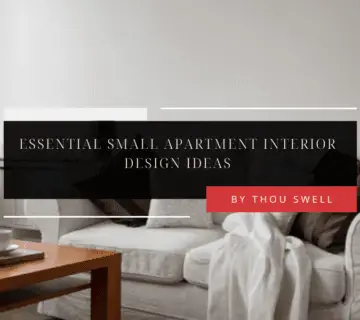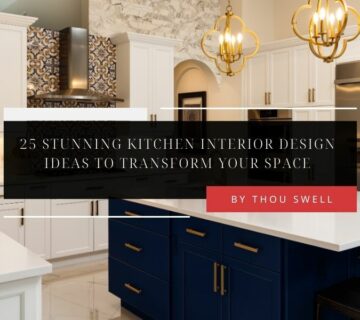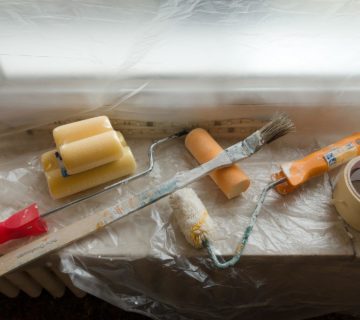Embracing tiny house living means adopting minimalism, focusing on what truly matters, and utilizing ingenious design ideas to make the most of limited space.
This article presents 11 genius interior design ideas to transform tiny homes. From multi-functional furniture and light color palettes to maximizing natural light and outdoor integration, each suggestion aims to enhance the functionality and aesthetics of tiny living spaces. We’ll also explore the benefits of decluttering and using sliding doors to save space.
Designed to guide you in maximizing every inch of your tiny home, these insights offer practical solutions for comfortable living. Ready to turn your tiny space into a big masterpiece of design and efficiency? Let’s begin.
What Is Tiny House Living?
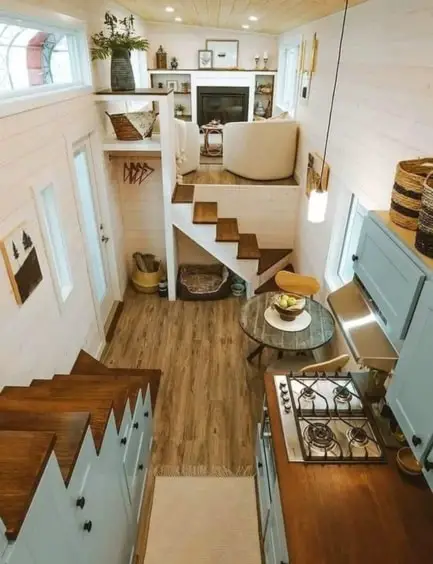
Tiny house living is all about embracing minimalism, sustainability, and simplicity by choosing to live in a small, often mobile, home. It’s a lifestyle choice that’s gaining popularity as people seek to downsize their living space and, in turn, upscale their quality of life. In essence, it’s about doing more with less: less square footage, less clutter, and less environmental impact.
Imagine living in a beautifully designed space where everything has its place, where the coziness of your living room blends seamlessly into the efficiency of your kitchen, all without moving an inch. Tiny house interior design isn’t just about making a small space work; it’s about creating functional, flexible spaces that reflect what’s truly important to you.
Whether it’s a lofted bed that doubles as a closet or a fold-down table that serves as a dining area and a workspace, tiny house living is about innovation. By focusing on simple designs and multifunctional furniture, residents of tiny homes can enjoy the freedom and flexibility that comes with having less, all while being part of a conscious shift towards more sustainable living.
Why Is Simple Design Key for Tiny Houses?
Simple design is the cornerstone of tiny house living for several good reasons:
- Maximizes functional space: In tiny homes, space is at a premium. Simple design focuses on functionality, making sure every inch serves a purpose. For instance, a bed that folds into a wall can double the living area available during the day.
- Promotes an uncluttered environment: Minimalist design helps keep the space looking and feeling neat. Without unnecessary decor or furnishings, the home feels more open and serene, making it a peaceful retreat.
- Enhances spatial perception: Simple designs often use clean lines and light colors, which can make small spaces appear larger. A bright, monochromatic color scheme can visually expand the room.
- Ensures timelessness: By opting for simplicity, tiny homes avoid the trap of fast-changing trends. This means the interior design remains stylish and relevant over the years, saving money and resources in the long run.
- Aligns with sustainable living: The essence of tiny house living is sustainability. A simple design reduces the need for excessive materials and decorations, minimizing the environmental footprint of the home.
- Facilitates flexibility: Simple, multifunctional furniture and designs allow for easy reconfiguration of the space. This adaptability is crucial in tiny living, where the same area may serve as a bedroom, living room, and office at different times.
Focusing on these principles can make tiny house living both practical and delightful, proving that simplicity is not just a design choice but a pathway to a more intentional and fulfilling life.
What Are the 11 Genius Small Space Simple Tiny House Interior Design Ideas?
Idea #1: Multi-Functional Furniture
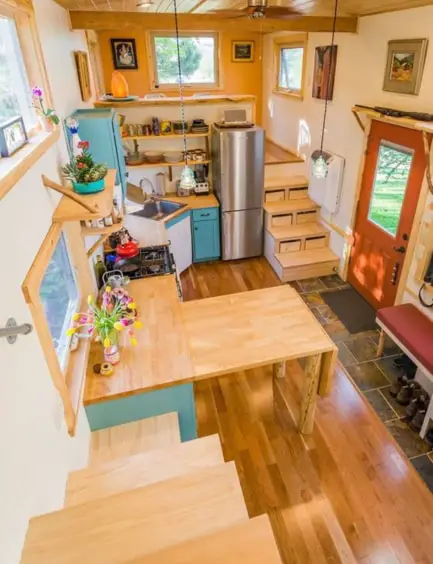
Multi-functional furniture is a game-changer in tiny house living. It offers flexibility and maximizes space by serving more than one purpose. Think of a sofa that turns into a bed, a dining table that expands or contracts based on needs, or ottomans with storage inside.
These pieces reduce clutter and eliminate the need for multiple furniture items, keeping the living area spacious and functional.
Idea #2: Vertical Space Utilization
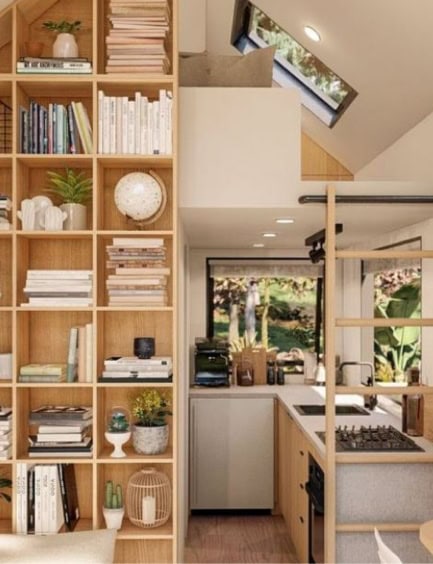
When floor space is limited, looking up opens a realm of possibilities. Using vertical space for storage or décor can drastically increase a tiny house’s usability. Installing shelves high on walls, using tall, slim cabinets, or even a ceiling-mounted hanging rack for pots and pans in the kitchen can free up valuable floor space while keeping essentials within reach.
Idea #3: Light Color Palettes
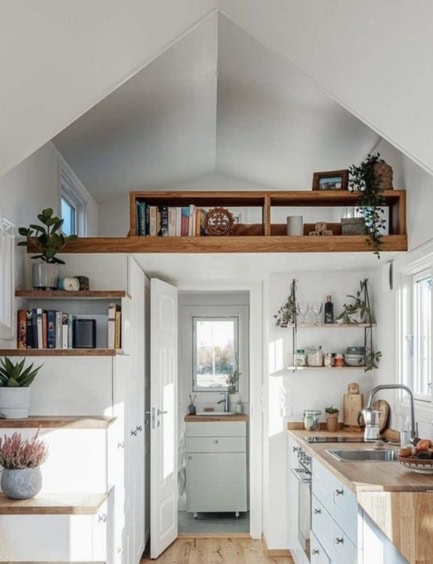
Light colors make small spaces appear larger and more inviting by reflecting light, rather than absorbing it. Soft whites, light grays, or pastel tones can brighten up a tiny home, making it feel airy and open. Combining a light color palette with strategic lighting can enhance this effect, amplifying the sense of space.
Idea #4: Mirrors to Expand Visual Space
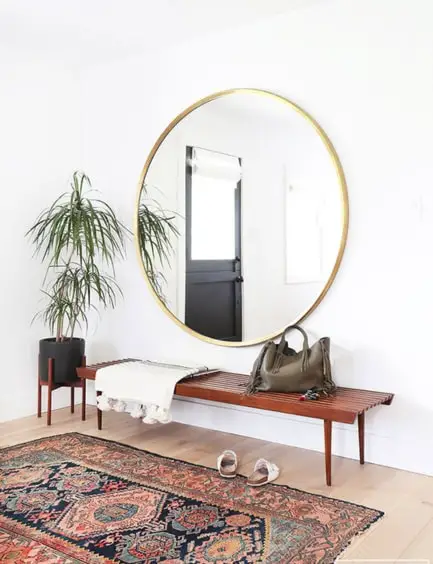
Mirrors can magically make a tiny space feel twice its size. Positioned opposite windows, mirrors can bounce natural light around a room, dramatically brightening and enlarging the space. Whether it’s a large statement mirror or a collection of smaller ones, mirrors add depth and dimension to small interiors.
Idea #5: Built-in Storage Solutions
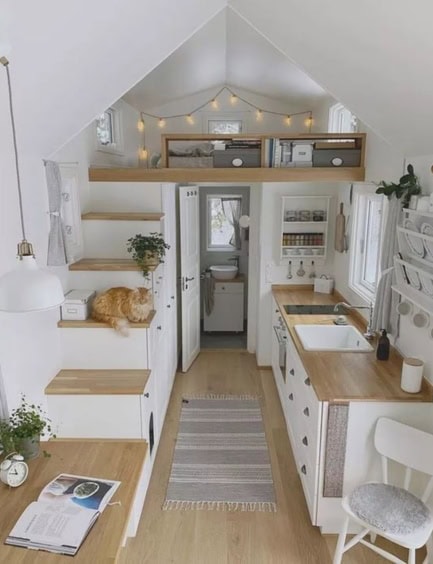
Built-in storage makes the most of limited square footage by blending storage seamlessly into the design of the house. Think of under-stair drawers, wall recesses, or floor-to-ceiling shelving that fits snugly into any unused nook. These solutions keep clutter out of sight and contribute to a clean, organized home.
Idea #6: Convertible Spaces
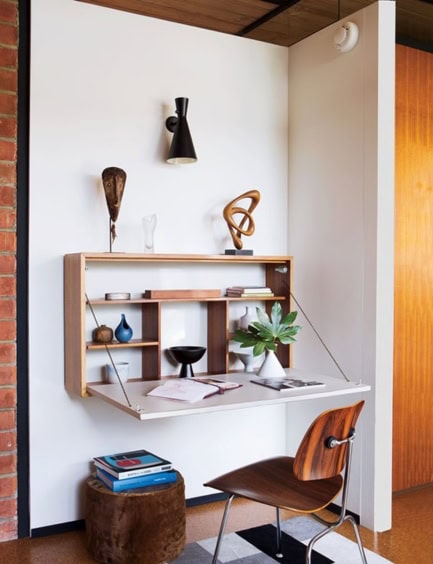
Adaptable or convertible spaces are essential in tiny living. Furniture and areas that transform for different uses can significantly enhance functionality. For example, a drop-down desk mounted on a wall, a bed that folds up into a closet, or a movable partition that divides a room can all change function as needed, providing flexibility and variety in daily living.
Idea #7: Decluttering Regularly
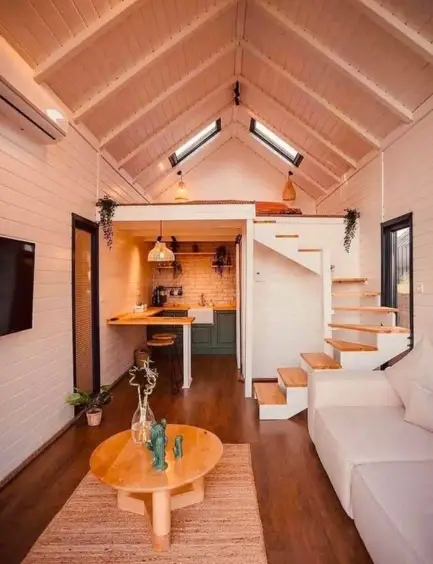
Decluttering isn’t just a one-time activity but an ongoing practice in tiny-house living. Regularly assessing what items are truly necessary helps to prevent the accumulation of non-essentials, ensuring the space remains open and stress-free. Embracing minimalism in possessions not only clears space but also aligns with the sustainability ethos of tiny living.
Idea #8: Large Windows for Natural Light
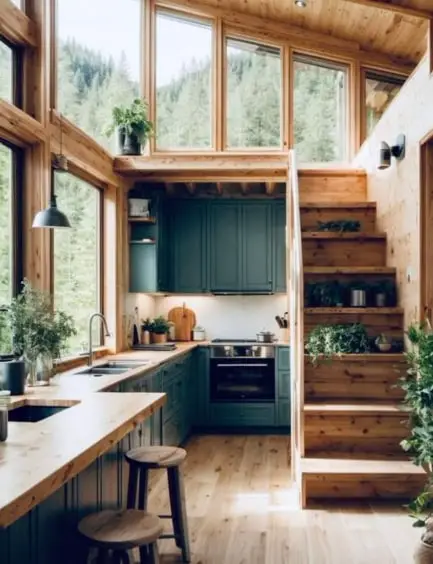
Incorporating large windows enhances both the visual and perceived size of a tiny house. Natural light floods the space, making it feel expansive and welcoming. Windows also connect the indoors with the outdoor environment, further eliminating feelings of confinement and promoting a healthy, airy living space.
Idea #9: Outdoor Integration
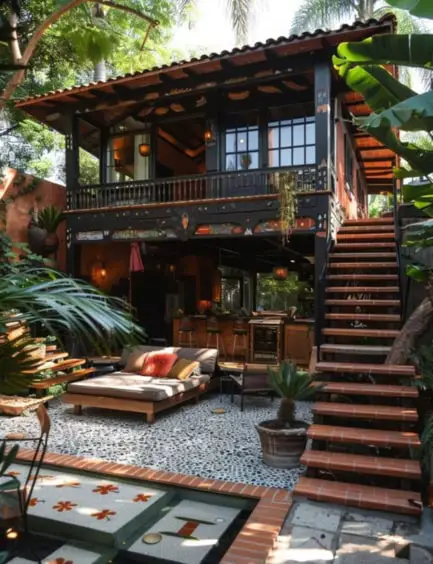
Expanding living space outdoors significantly enhances tiny house living. Decks, patios, or even just a set of French doors that open up to the outside can blur the boundary between indoor and outdoor spaces. This connection not only increases the living area but also enhances the enjoyment and functionality of a tiny home.
Idea #10: Sliding Doors
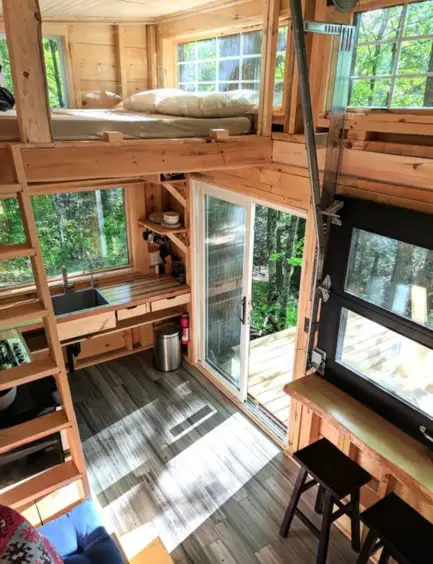
Sliding doors save more space than traditional swing doors and are an excellent solution for tiny houses. They can conceal or reveal spaces such as bedrooms, bathrooms, or closets, without requiring clearance for a door swing, making every inch of space usable and flexible.
Idea #11: Customization to Personal Needs
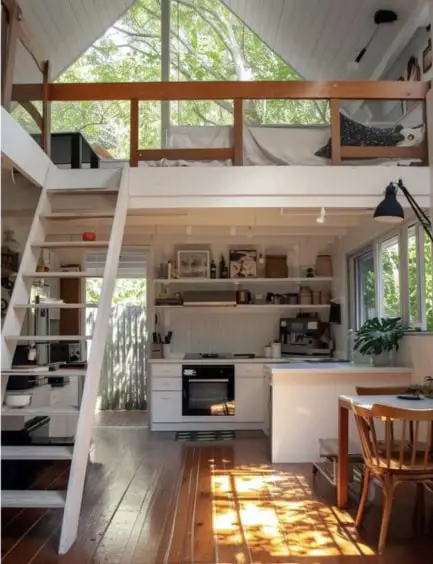
Ultimately, the most genius designs are those tailored to the individual’s lifestyle and needs. Customizing storage, furniture, and living spaces to fit personal habits and preferences makes a tiny house truly a home. Personal touches ensure that the design not only maximizes space but also supports a comfortable, personalized living experience.
Implementing these strategies in tiny house interior design can transform small spaces into functional, beautiful homes that feel both open and cozy. Each idea contributes to the overarching goal of enhancing the quality of life through thoughtful, intentional living spaces.
What Are the Must-Have Accessories for a Tiny House?
Accessorizing a tiny house involves picking items that are not only aesthetically pleasing but also serve a purpose, enhancing the functionality and comfort of your tiny living space. Here are some must-have accessories for any tiny house:
- Multi-purpose rugs: Rugs can define spaces, add warmth, and inject character into a tiny home. Opt for lightweight, easy-to-clean rugs that can be moved or rolled away when you need more floor space.
- Wall-mounted lighting: Floor space is precious in a tiny house, so opting for wall-mounted or hanging lights can save space while still providing ample illumination. Plus, they can add a touch of style to your tiny home.
- Foldable or extendable table: A foldable or extendable table can serve as a dining table, workspace, and storage solution all in one. Choose a model that can be tucked away or minimized when not in use to free up space.
- Stackable chairs or stools: Chairs that stack or nest save space when you need it and provide extra seating for guests when necessary. They’re practical without sacrificing style or comfort.
- Mirrors: Mirrors are essential for making tiny spaces feel larger and brighter. A well-placed mirror reflects natural light and visually doubles your living area.
- Vertical planters: Bring life and color into your tiny house with vertical planters. They take up minimal space while purifying the air and boosting your mood.
- Under-bed storage containers: Utilize the space under your bed with storage containers. It’s the perfect spot to store out-of-season clothing, extra bedding, or any items you don’t need daily access to.
- Smart home devices: Smart home devices such as thermostats, lights, and security cameras can enhance your living experience by making it more convenient and energy-efficient. They take up minimal space and can often be controlled through a single app.
- Space-saving kitchen gadgets: Opt for kitchen gadgets that serve multiple purposes, such as a compact air fryer, a blender that doubles as a food processor, or a foldable drying rack. These items save on counter and storage space.
- Over-the-door organizers: Make the most of every inch by using over-the-door organizers in your closet, bathroom, or pantry. They’re great for storing shoes, spices, cleaning supplies, and more, without taking up floor space.
- Compact entertainment options: Instead of a large TV, consider a projector that can be tucked away when not in use, or opt for a small, wall-mounted smart TV. Similarly, a small Bluetooth speaker delivers great sound without occupying too much space.
How Can Technology Aid in Tiny House Interior Design?
In the compact world of tiny houses, technology plays a pivotal role in maximizing space and enhancing the living experience. Here’s how technology can significantly aid tiny house interior design:
Smart Storage and Furniture
- Automated solutions: Shelves and storage that descend or fold out on demand save space and reduce clutter by making use of vertical spaces and hidden compartments.
- Transformative furniture: Coffee tables that become dining tables or beds that retract into the ceiling at the push of a button allow a single space to serve multiple functions throughout the day.
Compact Appliances and Home Automation
- High-efficiency appliances: Smaller, energy-efficient appliances like fridge drawers and combo washer-dryers keep tiny kitchens and bathrooms functional without overcrowding.
- Home automation: Control lighting, climate, and security systems from one device to save energy and streamline living in a compact space.
Entertainment and Connectivity
- Space-saving entertainment: Pull-down projector screens and wireless sound systems provide big entertainment without taking up space. Smart TVs can double as digital art displays.
- Seamless connectivity: Compact Wi-Fi solutions ensure that the home stays connected, supporting all smart devices and online activities.
Health, Comfort, and Design Tools
- Air and water quality: Air purifiers and water filters enhance health and comfort by improving indoor environmental quality.
- Design visualization: Virtual and augmented reality apps help in planning and visualizing interior design changes before they are made, ensuring optimal use of space.
By integrating these technologies, tiny houses can become smarter, more efficient, and more adaptable, enhancing the quality of life within a compact footprint.
Conclusion
Embracing small space simple tiny house interior design not only maximizes limited square footage but also enhances living quality through innovative, multifunctional solutions. From smart storage and furniture that adapts to your needs to the use of light colors, mirrors, and technology for a spacious feel, these strategies prove indispensable.
Whether it’s optimizing with vertical space or integrating outdoor elements, each idea brings us closer to achieving a comfortable, sustainable tiny home. Ready to transform your tiny house into a spacious sanctuary? Start implementing these genius design ideas today and experience the joy of tiny living maximized to its fullest potential.
